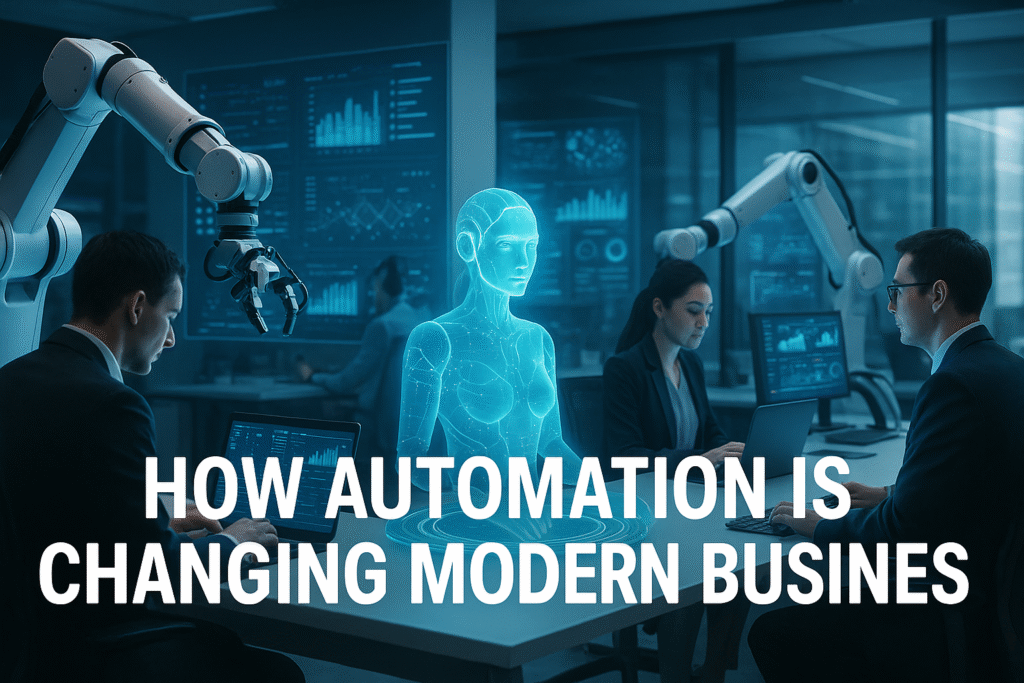🚀 Introduction
Automation has transformed from a buzzword into a business necessity.
In 2025, every successful company — from startups to global enterprises — is using automation to streamline operations, reduce costs, and boost productivity.
From AI-driven marketing to robotic process automation (RPA), automation isn’t just replacing manual tasks — it’s reshaping how modern businesses work, think, and grow.
⚙️ 1. What Is Business Automation?
Business automation means using technology to perform repetitive tasks without human intervention.
Common examples include:
- Automated email campaigns
- AI chatbots for customer service
- Inventory management systems
- Workflow automation tools like Zapier or Monday.com
The goal? Save time, reduce human error, and increase efficiency.
🧠 2. The Role of Artificial Intelligence (AI)
AI is the driving force behind next-generation automation.
It doesn’t just perform tasks — it learns from data to make smarter decisions over time.
AI automation examples:
- Predicting customer buying behavior
- Recommending personalized products
- Automating content creation and social media posts
- Analyzing huge data sets faster than any human could
💡 Example: Amazon uses AI-driven automation for pricing, logistics, and customer recommendations — creating a seamless shopping experience.
🤖 3. Robotic Process Automation (RPA) in Action
RPA uses software “bots” to handle repetitive back-office tasks such as:
- Invoice processing
- Payroll management
- Data entry
- Order tracking
Benefits of RPA:
- Works 24/7 without breaks
- Reduces operational costs
- Minimizes human error
- Scales easily with business growth
💡 Example: Banks use RPA to verify transactions, saving thousands of work hours each month.
🛒 4. Automation in E-Commerce and Marketing
Automation has become the backbone of digital marketing.
From personalized emails to predictive analytics, businesses now engage customers with minimal manual effort.
E-Commerce automation includes:
- Abandoned cart recovery emails
- AI chatbots for instant support
- Smart inventory restocking
- Dynamic ad campaigns that adapt in real time
💡 Tools like HubSpot, Klaviyo, and Mailchimp have made marketing automation accessible to even small online stores.
🏭 5. Manufacturing and Supply Chain Automation
In the industrial world, automation is boosting both efficiency and safety.
Examples include:
- Robots assembling products
- Automated quality inspections using AI cameras
- Self-managing supply chains using IoT sensors
These innovations have reduced production time and increased accuracy — helping companies scale faster than ever.
👨💼 6. How Automation Improves Employee Productivity
Contrary to popular fear, automation doesn’t replace all jobs — it redefines them.
By removing repetitive tasks, employees can focus on creativity, innovation, and customer experience.
Example:
A customer service agent can focus on solving complex issues while an AI chatbot handles routine FAQs.
🧭 Result: Happier employees + higher productivity = stronger business outcomes.
📊 7. Data-Driven Decision Making
Automation tools collect and analyze massive amounts of data instantly.
Business owners get real-time insights on performance, customer trends, and risks.
This data-driven approach helps:
- Predict market changes
- Improve decision accuracy
- Optimize resources
💡 Example: Google Ads and Meta use automated bidding algorithms to maximize ad performance with minimal human input.
🌍 8. Automation and Sustainability
Automation doesn’t just improve efficiency — it also supports sustainability.
How:
- Reduces paper and energy waste
- Streamlines logistics for fuel efficiency
- Enables remote work and digital operations
In short, automation contributes to a more eco-friendly and cost-efficient business ecosystem.
⚠️ 9. Challenges of Automation
While automation brings huge benefits, businesses must overcome key challenges:
- Initial setup and training costs
- Workforce resistance to change
- Data privacy and cybersecurity risks
However, with proper planning and education, these obstacles can be minimized.
💡 Tip: Invest in upskilling employees to work alongside automation tools — not against them.
🔮 10. The Future of Automation in Business
By 2030, automation will be as essential as the internet.
AI agents will manage workflows, schedule meetings, and even write content automatically.
Businesses that adopt automation early will enjoy:
- Lower operational costs
- Faster growth
- Better customer experiences
“Automation doesn’t remove the human element — it enhances it.”
✅ Conclusion
Automation is redefining the modern business landscape.
From AI chatbots to robotic warehouses, it’s enabling companies to do more with less.
As we move deeper into the digital age, one thing is clear:
Businesses that embrace automation will lead. Those that resist will lag behind.


